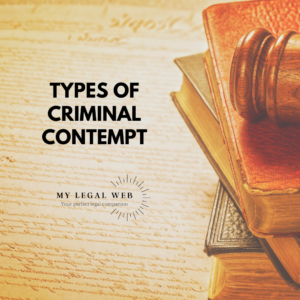What is contempt of court?
According to the case of Messrs Hisham Sobri & Kadir v Kedah Utara Development Sdn Bhd & Anor, there is no constitutional or statutory definition. However, it was held that contempt liability is primarily a common law phenomenon which will be further enriched by the litigation process in the case of civil contempt, or the prosecution of offenders and the summary treatment of contemnors in the case of criminal contempt.
Even so, one generally accepted definition has been given by William J in Miller v Knox who held that “It commonly consists in a party’s doing otherwise than he is enjoined to do or not doing what he is commanded or required by the process, order or decree of the court. More recently, this term has been defined as ‘an interference with the due administration of justice.”
Besides, Oswald in his book on Contempt of Court (3rd Ed, 1910) explained that contempt of court may be constituted by any conduct that tends to bring the authority and the administration of the law into disrespect or disregard, or to interfere with or prejudice parties, litigants, their witnesses during the litigation.
Purpose and objective of contempt of court
In the case of Chandra Sri Ram v Murray Hiebert, it was held that “The sole purpose of proceedings for contempt is to give our courts the power effectively to protect the rights of the public by ensuring that the administration of justice shall not be obstructed or prevented.”
What amounts to contempt of court?
Is there a difference between civil and criminal contempt?
- Criminal contempt is committed when the interference with the administration of justice is in the nature of a public wrong, like preventing a judge from giving judgment, threatening a process server or destroying evidence in a case.
- Civil contempt is used to compel obedience to the court’s orders and decrees, which are given pursuant to a dispute between litigants.
- The basis of the distinction is similar to that between crimes and torts generally — between public and private wrong, that is, in its character and purpose.
- For civil contempt, also known as ‘contempt in procedure’, the punishment is remedial and for the benefit of the complainant, whereas for criminal contempt, the act is one which so threatens the administration of justice that it requires punishment from a public point of view, which is punitive in nature.
- Civil contempt is fairly straightforward and the court exercises the power of contempt when a litigant initiates it, similar to an action in tort with the differences only in procedure, standard of proof and sanctions.
- On the other hand, criminal contempt has taken the form of many types of offences which can be broadly categorized into four main areas:
- Contempt in the face of the court
- Scandalizing the court
- Prejudicing or impeding court proceedings
- Interfering with the course of justice

